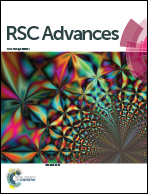Site-selection and adaptive reconstruction in a two-dimensional nanoporous network in response to guest inclusion†
Abstract
In the present investigation, we report the fabrication of a flexible binary network formed by tetraacidic azobenzene (NN4A) and trans-1,2-bis(4-pyridyl)ethylene (DPE) at the liquid–solid interface. When coronene (COR) molecule is added into these systems, the binary networks break and the reconstruction structures of NN4A/COR host–guest systems are subsequently formed. Scanning tunneling microscopy (STM) measurements, as well as density functional theory (DFT) calculations, reveal that the NN4A/COR host–guest system is the energetically favourable structure and with the most thermodynamic stability. These studies give us insight into a better comprehension of competitive adsorption for the fabrication of functional molecular assemblies.


 Please wait while we load your content...
Please wait while we load your content...